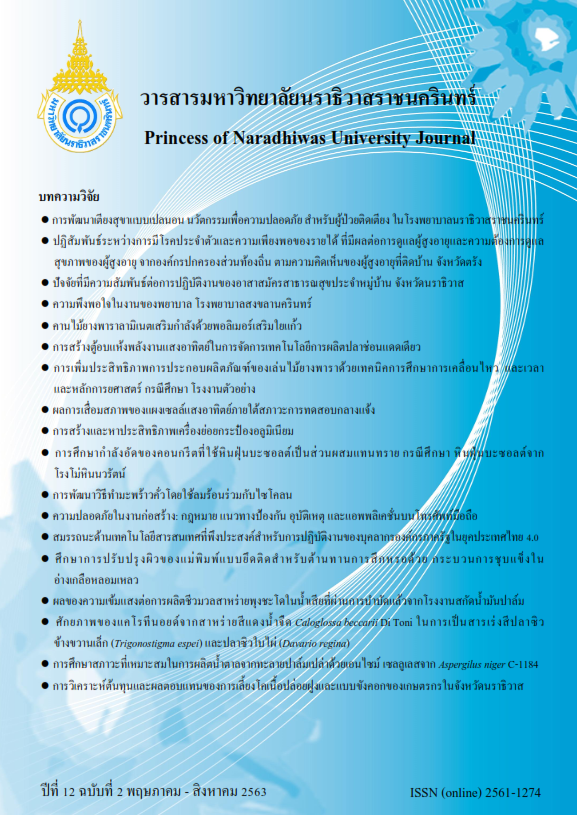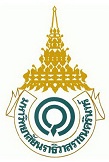การสร้างตู้อบแห้งพลังงานแสงอาทิตย์ในการจัดการเทคโนโลยีการผลิตปลาช่อนแดดเดียว
คำสำคัญ:
ตู้อบแห้งพลังงานแสงอาทิตย์, การจัดการเทคโนโลยี, ปลาช่อนแดดเดียวบทคัดย่อ
การวิจัยครั้งนี้มีวัตถุประสงค์เพื่อสร้างตู้อบแห้งพลังงานแสงอาทิตย์ในการผลิตปลาช่อนแดดเดียว โดยใช้วิธีวิจัยแบบผสมผสาน จากการสังเคราะห์ข้อมูลความต้องการในการสร้างตู้อบแห้งด้วยพลังงานแสงอาทิตย์ ประชากร คือกลุ่มแม่บ้านวิสาหกิจชุมชนแปรรูปอาหารปลาช่อนแดดเดียว ตำบลบางพุทรา อำเภอเมือง จังหวัดสิงห์บุรี จำนวน 10 คน ออกแบบตามหลักการของตู้อบแห้งพลังงานแสงอาทิตย์และหลักการยศาสตร์ ผลการวิจัยพบว่า ตู้อบแห้งพลังงานแสงอาทิตย์ที่ตอบสนองความต้องการของกลุ่มวิสาหกิจชุมชนคือโครงสร้างของตู้อบแห้งทำจากอะลูมิเนียม ขนาด 120x120x102 ลูกบาศก์เซนติเมตร น้ำหนักเบา เป็นวัสดุที่หาได้ง่ายในชุมชน มีล้อ สามารถเคลื่อนย้ายได้สะดวก มีชั้นวางผลิตภัณฑ์ที่สามารถถอดประกอบทำความสะอาดได้ง่าย บำรุงรักษาได้ด้วยตนเอง ลดพื้นที่การตากแห้ง ประสิทธิภาพการทำความร้อนในส่วนอบแห้งมีอุณหภูมิสูงกว่าอุณหภูมิอากาศภายนอกใน ช่วงที่แสงแดดเข้มสูงสุดต่างกัน 10-12 องศาเซลเซียส สามารถจ่ายลมร้อนสู่ห้องอบแห้งที่อุณหภูมิ
40 - 55 องศาเซลเซียส ทุกตำแหน่งของชั้นวางผลิตภัณฑ์มีอุณหภูมิใกล้เคียงกัน สามารถอบปลาช่อนครั้งละ 60 ตัว น้ำหนักตัว 250 - 350 กรัม ลดเวลาการตากแห้งจากแบบเดิมได้ 2 ชั่วโมง ความชื้นปลาหลังการอบแห้งลดลงเฉลี่ยร้อยละ 27 (wb) กลุ่มแม่บ้านวิสาหกิจชุมชนแปรรูปอาหารปลาช่อนแดดเดียวได้ใช้ตู้อบแห้งพลังงานแสงอาทิตย์ในการจัดแสดงสินค้าหนึ่งตำบลหนึ่งผลิตภัณฑ์ของจังหวัดสิงห์บุรี
References
Aktas, M., Ilhan, C., & Yilmaz, S. (2009). Determination of drying characteristics of apples in a heat pump and solar dryer. Desalination, 239(1-3), 266–275.
Bureau of Alternative Energy Development and Efficiency. (2014). Handbook of Solar Drying. Department of Alternative Energy Development and Efficiency. Ministry of Energy and Science Program in Physics Silpakorn University.
Hignett, S., & McAtamney, L. (2000). Rapid entire body assessment (REBA). Applied Ergonomics, 31, 201-205.
Homchad, K. (2018). Performance evaluation of a combined solar and biomass drying system. Engineering Journal of Research and Development, 29(3), 61-74. (in Thai).
Janjai, S. (2012). A greenhouse type solar dryer for small-scale dried food industries: Development and dissemination. International Journal of Energy and Environment, 3(3), 383-398.
Niyomvas, S, W., B., & Thaikul, A. (2018). Experimental study on drying conditions of solar controlled by open-closed ventilating system. The Journal of KMUTNB, 28(3), 525-536. (in Thai).
Lhendup, T. (2005). Technical and financial feasibility of a solar dryer in Bhutan. Energy for Sustainable Development, 9(4), 17-24.
Madhlopa, A., & Ngwalo., G. (2007). Solar dryer with thermal storage and biomass-backup heater. Solar Energy, 81(4), 449-462.
McAtamney, L., & Nigel Corlett. E. (1993). RULA: a survey method for the investigation of work- related upper limb disorders. Applied Ergonomics, 24(2), 91-99.
Ninchuewong, T., Ekphon, A., Tirawanichakul, S., & Tirawanichakul, Y. (2012). Drying of air dried sheet rubber using hot air dryer and solar dryer for small entrepreneurs and small rubber cooperatives. Burapha Science Journal, 17(2), 50–59. (in Thai)
Rathore, N.S., & Panwar, N.L. (2010). Experimental studies on hemi cylindrical walk-in type solar tunnel dryer for grape drying. Applied Energy, 87(8), 2764-2767.
Safety and Health at Work Promotion Association (Thailand). (2009). Ergonomics, Retrieved from http://www.shawpat.or.th/index.php?option=com_content&view =category&id=50&Itemid= 204 20 June. (in Thai).
Singsorn, N., Thapo, R., & Wetchakul K. (2014). Solar oven made from polycarbonate sheets. Rajabhat Agriculture Journal, 13(1), 47-52. (in Thai).
Taikhao, A., & Takhasap, S. (2013). Natural convection and forced convection solar dryers. EAU Heritage Journal Science and Technology, 7(1), 23-31. (in Thai).
Taikhao, A., & Theekhasub, S. (2016). Solar dryer types of natural convection and forced convection type. EAU Heritage Journal Science and Technology, 7(1), 23-31. (in Thai).



